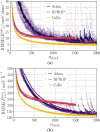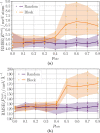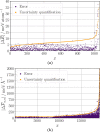Lifelong Machine Learning Potentials
- PMID: 37288932
- PMCID: PMC10308836
- DOI: 10.1021/acs.jctc.3c00279
Lifelong Machine Learning Potentials
Abstract
Machine learning potentials (MLPs) trained on accurate quantum chemical data can retain the high accuracy, while inflicting little computational demands. On the downside, they need to be trained for each individual system. In recent years, a vast number of MLPs have been trained from scratch because learning additional data typically requires retraining on all data to not forget previously acquired knowledge. Additionally, most common structural descriptors of MLPs cannot represent efficiently a large number of different chemical elements. In this work, we tackle these problems by introducing element-embracing atom-centered symmetry functions (eeACSFs), which combine structural properties and element information from the periodic table. These eeACSFs are key for our development of a lifelong machine learning potential (lMLP). Uncertainty quantification can be exploited to transgress a fixed, pretrained MLP to arrive at a continuously adapting lMLP, because a predefined level of accuracy can be ensured. To extend the applicability of an lMLP to new systems, we apply continual learning strategies to enable autonomous and on-the-fly training on a continuous stream of new data. For the training of deep neural networks, we propose the continual resilient (CoRe) optimizer and incremental learning strategies relying on rehearsal of data, regularization of parameters, and the architecture of the model.
Conflict of interest statement
The authors declare no competing financial interest.
Figures






References
-
- Cramer C. J.Essentials of Computational Chemistry: Theories and Models; Wiley, 2013.
-
- Jensen F.Introduction to Computational Chemistry; Wiley, 2017.
-
- Das S.; Motamarri P.; Gavini V.; Turcksin B.; Li Y. W.; Leback B.. Fast, scalable and accurate finite-element based ab initio calculations using mixed precision computing: 46 PFLOPS simulation of a metallic dislocation system. International Conference for High Performance Computing, Networking, Storage and Analysis (SC19). Denver, CO, USA, 2019.
LinkOut - more resources
Full Text Sources

